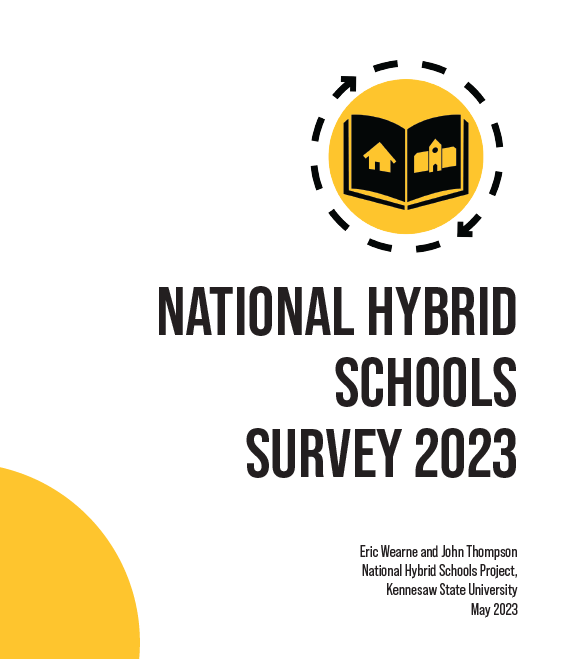
At this year’s hybrid schools conference, we had a session focused on research related to hybrid schooling. This year, that session included presentations from John Thompson with the National Hybrid Schools Project at Kennesaw State, on a new paper looking at commuting data and hybrid schools; research from Matthew Lee at ACSI, and from Ben DeGrow with ExcelinEd. We had a research session at our inaugural conference too, with presentations by Kennesaw State, EdChoice, Prenda Learning, and Bellwether Education Partners. We’ll always have at least one session on academic research, as this kind of work helps us make some sense of a quickly-evolving landscape, and talk about what’s going on in a (sort-of) systematic way. One of the strengths of the conference is the combination of this kind of academic work with the live-on-the-ground work school founders, leaders, and teachers are doing. We actually had a session at the 2023 conference moderated by Mike McShane, the entire purpose of which was to bring together researchers and practitioners. I find this kind of interaction very useful in informing the policy conversations that are happening these days.
This year has seen a good bit of new research on permissionless school models like hybrid schools, microschools, and others:
This spring the National Microschooling Center published their “sector analysis,” looking at over 100 microschools.
Kerry McDonald with FEE just recently published the results of her work interviewing education entrepreneurs around the country.
We also recently got the publication of VELA’s Open for Business report, a survey of their grant recipients.
And of course EdChoice continues their public opinion tracker, which currently finds almost 60 percent of families saying they want their kids to learn at home at least one day per week.
And so along with all of these, I am pleased to announce that we at the National Hybrid Schools Project have just posted our second annual National Hybrid Schools Survey. Before I get into those results, I want to note that this is just the latest in the series of research pieces the National Hybrid Schools Project has been posting/will post to our website.
The first was our first nationwide survey, in 2022. That was really the first effort at collecting some nationwide numbers specifically from hybrid schools.
Later last year, we posted a survey of hybrid school teachers. In that report, we found, for example:
Hybrid school teachers seem to have somewhat less experience in the classroom than their conventional school counterparts, and they seem to make less money.
However, hybrid school teachers also (over 95 percent of them) tend to be satisfied with teaching at their schools, and agree with the statement, "Most of my colleagues share my beliefs and values about what the central mission of the school should be."
(Maybe there is some selection bias there, but I would argue that it would be hard to get 95 percent of teachers in any school to agree on almost any topic, much less one like "Most of my colleagues share my beliefs and values about what the central mission of the school should be." I think that really does say something about the cultures being cultivated in hybrid schools all over).
We just finished data collection for a survey about hybrid school facilities, so look for that to come out later this year. I have literally no idea what these results are going to be but I’m particularly interested in part because of reasons I wrote about last week.
Conducting research these kinds of schools is not easy in some of the same ways conducting research on homeschoolers is not easy – you’re never totally sure what the denominator is. And it’s complicated a little bit more because of the gray policy zone most of these schools operate in. Sometimes hybrid schools especially operate in a quantum realm, where they’re sometimes homeschoolers and sometimes not.
These annual surveys are important because this is the only effort systematically looking at the hybrid school sector. I’ve noted in the past that some percentage of the huge growth in “homeschooling” over the past few years is actually capturing students enrolled in hybrid schools and microschools, but saying they are homeschoolers. Hybrid schoolers are especially hard to pin down. Sometimes they will call themselves homeschoolers. In some cases, they will show up in datasets as private schoolers. In others, say those in charter school versions, or in conventional school system programs, as public school students. Some hybrid schools have some of their students register as homeschoolers, and others not, depending on grade level, etc. And so what we do is curate a list of hybrid schools around the country, and survey the leaders of those schools every fall. Our dataset is always evolving, but it’s growing, and ultimately provides the best, most consistent look at this particular school sector, in a consistent way.
Back to this latest survey. Here are some of the highlights:
Hybrid schools seem to be growing in number and in size. The average enrollment has consistently grown over the past several years, from an average of 152 in 2018 to an average of 194 in 2022.
The average hybrid school responding to this survey was founded in 2012, with a significant percentage founded in the last 3-5 years.
Hybrid schools participate in several kinds of school choice programs, but a number of them do not participate even when they are available.
Please do read the whole report. For now I’d like to focus on that last bullet. From the report:
“Schools reported participating in a wide variety of school choice programs: education savings accounts, (ESAs), tuition tax credits, or other programs. It is worth noting that in some states – Georgia and Missouri, for example – some schools responded that there are no programs available, while others reported participating in specific programs. This suggests that some number of hybrid schools may not be aware of school choice programs that their families might be eligible for. 2024 may present an interesting change in these results, as a number of state legislatures are passing ESA-style bills in 2023, many of which are universal, which would make accessing hybrid schools easier for a larger number of families.”
As I noted at the start of this post, there is some need for connections between researchers and practitioners, and also policymakers. All of those groups’ work inform the others. Leave lobbying for particular bills aside; I just mean this in the sense that even when these groups want sort of the same things, it can be hard to implement those things. I think our conference is a good place for interesting conversations on implementation issues to happen. And I think having academic research available to point out how things are going, or, in this case, instances where things like enacted policies and practicioners’ knowledge do not seem to be lining up. West Virginia might be a really interesting/extreme case to look at for this kind of thing, as they have a big, brand new choice program, but no real history of school choice implementation or access to build on. Research efforts like the ones I’ve noted are happening more often, and they’re helping us understand what’s going on and how things are likely to proceed. More to come.




